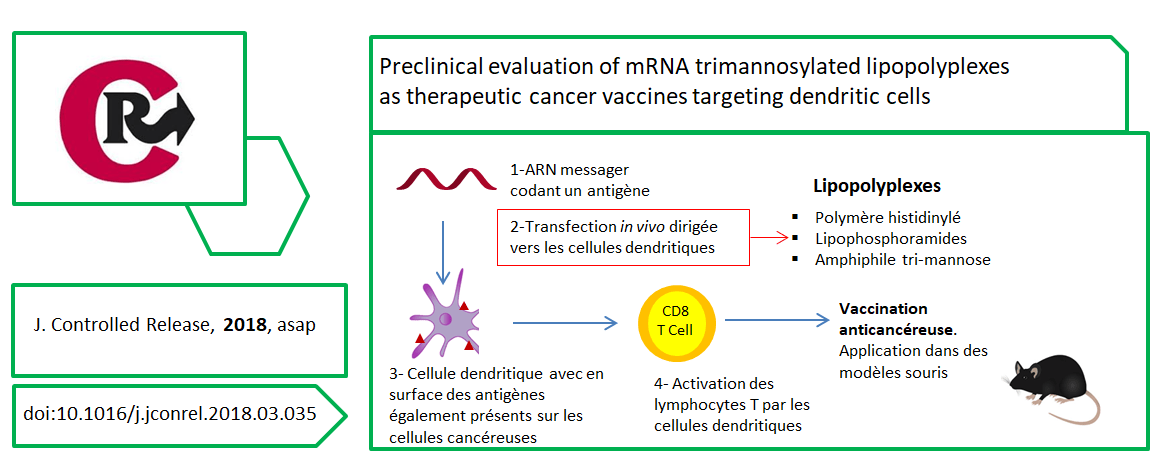[:fr] Nouvelle publication de l’équipe COSM : « Preclinical evaluation of mRNA trimannosylated lipopolyplexes as therapeutic cancer vaccines targeting dendritic cells. »
Nouvelle publication de l’équipe COSM : « Preclinical evaluation of mRNA trimannosylated lipopolyplexes as therapeutic cancer vaccines targeting dendritic cells. »
A. Le Moignic, V. Malard, T. Benvegnu, L. Lemiègre, M. Berchel, P.-A. Jaffrès, C. Baillou, M. Delost, R. Macedo, J. Rochefort, G. Lescaille, C. Pichon, F.M. Lemoine, P. Midoux, V. Mateo
doi:10.1016/j.jconrel.2018.03.035
Ce travail rapporte la transfection de cellules dendritiques in vivo avec des ARNm codant des antigènes exprimés au niveau de cellules cancéreuses. La transfection est réalisée par une pré-compaction de l’ARNm par un polymères suivi de l’ajout d’un liposomes constitués de lipophosphoramides et d’un amphiphiphile tri-manosylé. Il est montré que cette stratégie permet d’accroitre la réponse immunitaire contre ces cellules cancéreuses conduisant à un effet bénéfique pour la survie des souris.
New publication of COSM team : « Preclinical evaluation of mRNA trimannosylated lipopolyplexes as therapeutic cancer vaccines targeting dendritic cells. »
A. Le Moignic, V. Malard, T. Benvegnu, L. Lemiègre, M. Berchel, P.-A. Jaffrès, C. Baillou, M. Delost, R. Macedo, J. Rochefort, G. Lescaille, C. Pichon, F.M. Lemoine, P. Midoux, V. Mateo
doi:10.1016/j.jconrel.2018.03.035
Clinical trials with direct administration of synthetic mRNAs encoding tumor antigens demonstrated safety and induction of tumor-specific immune responses. Their proper delivery to dendritic cells (DCs) requires their protection against RNase degradation and more specificity for dose reduction. Lipid-Polymer-RNA lipopolyplexes (LPR) are attractive mRNA delivery systems and their equipment with mannose containing glycolipid, specific of endocytic receptors present on the membrane of DCs is a valuable strategy. In this present work, we evaluated the capacity of LPR functionalized with a tri-antenna of α-D-mannopyranoside (triMN-LPR) concerning (i) their binding to CD209/DC-SIGN and CD207/Langerin expressing cell lines, human and mouse DCs and other hematopoietic cell populations, (ii) the nature of induced immune response after in vivo immunization and (iii) their therapeutic anti-cancer vaccine efficiency. We demonstrated that triMN-LPR provided high induction of a local inflammatory response two days after intradermal injection to C57BL/6 mice, followed by the recruitment and activation of DCs in the corresponding draining lymph nodes. This was associated with skin production of CCR7 and CXCR4 at vaccination sites driving DC migration. High number of E7-specific T cells was detected after E7-encoded mRNA triMN-LPR vaccination. When evaluated in three therapeutic pre-clinical murine tumor models such as E7-expressing TC1 cells, OVA-expressing EG7 cells and MART-1-expressing B16F0 cells, triMN-LPR carrying mRNA encoding the respective antigens significantly exert curative responses in mice vaccinated seven days after initial tumor inoculation. These results provide evidence that triMN-LPR give rise to an efficient stimulatory immune response allowing for therapeutic anti-cancer vaccination in mice. This mRNA formulation should be considered for anti-cancer vaccination in Humans[:]
